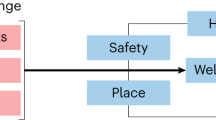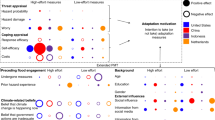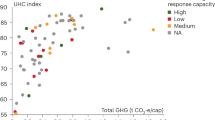Abstract
Society's response to every dimension of global climate change is mediated by culture. We analyse new research across the social sciences to show that climate change threatens cultural dimensions of lives and livelihoods that include the material and lived aspects of culture, identity, community cohesion and sense of place. We find, furthermore, that there are important cultural dimensions to how societies respond and adapt to climate-related risks. We demonstrate how culture mediates changes in the environment and changes in societies, and we elucidate shortcomings in contemporary adaptation policy.
This is a preview of subscription content, access via your institution
Access options
Subscribe to this journal
Receive 12 print issues and online access
$209.00 per year
only $17.42 per issue
Buy this article
- Purchase on Springer Link
- Instant access to full article PDF
Prices may be subject to local taxes which are calculated during checkout
Similar content being viewed by others
References
National Research Council America's Climate Choices: Adapting to the Impacts of Climate Change (National Academies Press, 2010).
Douglas, M. & Wildavsky, A. Risk and Culture: An Essay on the Selection of Technological and Environmental Dangers (Univ. California Press, 1982).
Shove, E. Comfort, Cleanliness and Convenience: The Social Organization of Normality (Berg, 2003).
Hulme, M. The conquering of climate: Discourses of fear and their dissolution. Geogr. J. 174, 5–16 (2008).
Swidler, A. Culture in action: Symbols and strategies. Am. Sociol. Rev. 51, 273–286 (1986).
Hays, S. Structure and agency and the sticky problem of culture. Sociol. Theory 12, 57–72 (1994).
Escobar, A. Culture sits in places: Reflections on globalism and subaltern strategies of localization. Polit. Geogr. 20, 139–179 (2001).
McPherson, M., Smith-Lovin, L. & Cook, J. Birds of a feather: Homophily in social networks. Annu. Rev. Sociol. 27, 415–444 (2001).
Hess, J. J., Malilay, J. N. & Parkinson, A. J. Climate change: The importance of place. Am. J. Prevent. Med. 35, 468–478 (2008).
Kirsch, S. Lost worlds: Environmental disaster, 'culture loss', and the law. Curr. Anthropol. 42, 167–198 (2001).
Brace, C. & Geoghegan, H. Human geographies of climate change: Landscape, temporality, and lay knowledges. Prog. Human Geogr. 35, 284–302 (2011).
Berkes, F. Understanding uncertainty and reducing vulnerability: Lessons from resilience thinking. Natural Hazards 41, 283–295 (2007).
O'Brien, K. in Adapting to Climate Change: Thresholds, Values, Governance (eds Adger, W. N., Lorenzoni, I. & O'Brien, K.) 164–180 (Cambridge Univ. Press, 2009).
Crate, S. A. Gone the bull of winter? Grappling with the cultural implications of and anthropology's role(s) in global climate change. Curr. Anthropol. 49, 569–595 (2008).
Garrett, B. L. Drowned memories: The submerged places of the Winnemem Wintu. Archaeologies, 6, 346–371 (2010).
Twigger-Ross, C. L. & Uzzell, D. L. Place and identity processes. J. Environ. Psychol. 16, 205–220 (1996).
Hidalgo, M. C. & Hernandez, B. Place attachment: Conceptual and empirical questions. J. Environ. Psychol. 21, 273–281 (2001).
Lewicka, M. What makes neighbourhood different from home and city? Effects of place scale on place attachment. J. Environ. Psychol. 30, 35–51 (2010).
Flora, J. L. Social capital and communities of place. Rural Sociol. 63, 481–506 (1998).
Stedman, R. C. Sense of place as an indicator of community sustainability. Forest. Chron. 75, 765–770 (1999).
Igor, K. Attachment and identity as related to a place and its perceived climate. J. Environ. Psychol. 25, 207–218 (2005).
Agyeman, J., Devine-Wright, P. & Prange, J. Close to the edge, down by the river? Joining up management retreat and place attachment in a climate change world. Environment and Planning A 41, 509–513 (2009).
Adger, W. N., Barnett, J., Chapin III, F. S. & Ellemor, H. This must be the place: Under representation of identity and meaning in climate change decision-making. Global Environmental Politics 11 (2), 1–25 (2011).
Field, D. R. & Burch, W. R. J. Rural Sociology and the Environment (Greenwood, 1988).
Barnett, J. and O'Neill, S. Islands, resettlement and adaptation. Nature Clim. Change 2, 8–10 (2012).
Morgan, P. Towards a developmental theory of place attachment. J. Environ. Psychol. 30, 11–22 (2010).
Raymond, C. M., Brown, G. & Weber, D. The measurement of place attachment: Personal, community, and environmental connections. J. Environ. Psychol. 30, 422–434 (2010).
Scannell, L. & Gifford, R. Defining place attachment: A tripartite organizing framework. J. Environ. Psychol. 30, 1–10 (2010).
Hernández, B., Martín, A. M., Ruiz, C. & Hidalgo, M. C. The role of place identity and place attachment in breaking environmental protection laws. J. Environ. Psychol. 30, 281–288 (2010).
Danglova, O. Rural-community in the process of socioeconomic changes. Colleg. Antropol 19, 129–144 (1995).
Fried, M. Continuities and discontinuities of place. J. Environ. Psychol. 20, 193–205 (2000).
Force, J. E., Machlis, G. E., Zhang, C. & Kearney, A. The relationship between timber production, local historical events, and community social change: A quantitative case study. Forest Sci. 39, 722–742 (1993).
Nielsen, J. Ø. & Reenberg, A. Cultural barriers to climate change adaptation: A case study from Northern Burkina Faso. Glob. Environ. Change 20, 142–152 (2010).
Coulthard, S. Adapting to environmental change in artisanal fisheries: Insights from a South Indian Lagoon. Glob. Environ. Change 18, 479–489 (2008).
DeMenocal, P. B. Cultural responses to climate change during the late Holocene. Science 292, 667–673 (2001).
Bravo, M. T. Voices from the sea ice: The reception of climate impact narratives. J. Histor. Geog. 35, 256–278 (2009).
Kuruppu, N. & Liverman, D. Mental preparation for climate adaptation: The role of cognition and culture in enhancing adaptive capacity of water management in Kiribati. Glob. Environ. Change 21, 657–669 (2011).
Rudiak-Gould, P. Climate change and anthropology: The importance of reception studies. Anthropol. Today 27, 9–12 (2011).
Blinman, E. 2000 years of cultural adaptation to climate change in the southwestern United States. Ambio 37, 489–497 (2008).
Jacob, C., McDaniels, T. & Hinch, S. Indigenous culture and adaptation to climate change: Sockeye salmon and the St'át'imc people. Mitig. Adapt. Strateg. Glob. Change 15, 859–876 (2010).
Fox, S. in The Earth is Faster Now: Indigenous Observations of Arctic Environmental Change (eds Krupnik, I. & Jolly, D.) 13–53 (ARCUS, 2002).
Mishra, S., Mazumdar, S. & Suar, D. Place attachment and flood preparedness. J. Environ. Psychol. 30, 187–197 (2010).
Marshall, N. A., Fenton, D. M., Marshall, P. A. & Sutton, S. How resource-dependency can influence social resilience within a primary resource industry. Rural Sociol. 72, 359–390 (2007).
Devine-Wright, P. Rethinking nimbyism: The role of place attachment and place identity in explaining place-protective action. J. Commun. Appl. Soc. Psychol. 19, 426–441 (2009).
Scannell, L. & Gifford, R. The relations between natural and civic place attachment and pro-environmental behavior. J. Environ. Psychol. 30, 289–297 (2010).
Wolf, J., Brown, K. & Conway, D. Ecological citizenship and climate change: Perceptions and practice. Environ. Polit. 18, 503–521 (2009).
Boudon, R. The Origin of Values: Sociology and Philosophy of Beliefs (Transaction, 2001).
O'Brien, K. & Wolf, J. A values-based approach to vulnerability and adaptation to climate change. WIREs Clim. Change 1, 232–242 (2010).
Hulme, M. Why We Disagree about Climate Change (Cambridge Univ. Press, 2009).
Kothari, U. in Participation: The New Tyranny? (eds Cooke, B. & Kothari, U.) 139–152 (Zed, 2001).
Norgaard, K. Living in Denial: Climate Change, Emotions, and Everyday Life (MIT Press, 2011).
Aakre, S. & Rübbelke, D. T. G. Objectives of public economic policy and the adaptation to climate change. J. Environ. Planning Manage. 53, 767–791 (2010).
Tompkins, E. L. et al. Observed adaptation to climate change: UK evidence of transition to a well-adapting society. Glob. Environ. Change 20, 627–635 (2010).
Biesbroek, G. R. et al. Europe adapts to climate change: Comparing national adaptation strategies. Glob. Environ. Change 20, 440–450 (2010).
Abel, N. et al. Sea level rise, coastal development and planned retreat: Analytical framework, governance principles and an Australian case study. Environ. Sci. Policy 14, 279–288 (2011).
Godden, L., Ison, R. & Wallis, P. J. Water governance in a climate change world: Appraising systemic and adaptive effectiveness. Wat. Resour. Manage. 25, 3971–3976 (2011).
Loring, P. & Gerlach, S. Food, culture, and human health in Alaska: An integrative health approach to food security. Environ. Sci. Policy 12, 466–478 (2009).
Brooks, N., Grist, N. & Brown, K. Development futures in the context of climate change: Challenging the present and learning from the past. Dev. Policy Rev. 27, 741–765 (2009).
Adger, W. N. et al. Resilience implications of policy responses to climate change. WIREs Clim. Change 2, 757–766, (2011).
Dixon, J. & Durrheim, K. Dislocating identity: Desegregation and the transformation of place. J. Environ. Psychol. 24, 455–473 (2004).
Nelson, R., Howden, M. & Stafford-Smith, M. Using adaptive governance to rethink the way science supports Australian drought policy. Environ. Sci. Policy 11, 588–601 (2008).
Hurlimann, A. & Dolnicar, S. Voluntary relocation: An exploration of Australian attitudes in the context of drought, recycled and desalinated water. Glob. Environ. Change 21, 1084–1094 (2011).
Crate, S. A. Climate and culture: Anthropology in the era of contemporary climate change. Annu. Rev. Anthropol. 40, 175–194 (2011).
Nelson, D. R., West, C. T. & Finan, T. J. Introduction to “In focus: global change and adaptation in local places”. Am. Anthropol. 111, 271–274 (2009).
Roncoli, C., Crane, T. & Orlove, B. in Anthropology and Climate Change: From Encounters to Action (eds Crate, S. A. & Nuttall, M.) 87–115 (Left Coast, 2009).
Dumaru, P. Community-based adaptation: Enhancing community adaptive capacity in Druadrua Island, Fiji. WIREs Clim. Change 1, 751–763 (2010).
Ensor, J. & Berger, R. in Adapting to Climate Change: Thresholds, Values, Governance (eds Adger, W. N., Lorenzoni, I. & O'Brien, K.) 237 (Cambridge Univ. Press, 2009).
Dietz, T. & Stern, P. C. (eds) Public Participation in Environmental Decision-making. (National Academies, 2008).
Few, R., Brown, K. & Tompkins, E. Public participation and climate change adaptation: avoiding the illusion of inclusion. Clim. Policy 7, 46–59 (2007).
Nicholson-Cole, S. & O'Riordan, T. in Adapting to Climate Change: Thresholds, Values, Governance (eds Adger, W. N., Lorenzoni, I. & O'Brien, K.) 368–383 (Cambridge Univ. Press, 2009).
Marino, E. The long history of environmental migration: Assessing vulnerability construction and obstacles to successful relocation in Shishmaref, Alaska. Glob. Environ. Change 22, 374–381 (2012).
Lawrence, A. The first cuckoo in winter: Phenology, recording, credibility and meaning in Britain. Glob. Environ. Change 19, 173–179 (2009).
Smith, K. An army of observers. Nature Clim. Change 1, 79–82 (2011).
Tache, B. & Oba, G. Is poverty driving Borana herders in southern Ethiopia to crop cultivation? Hum. Ecol. 38, 639–649 (2010).
Galvin, K. A. Transitions: Pastoralists living with change. Annu. Rev. Anthropol. 38, 185–198 (2009).
Foale, S. J. Conserving Melanesia's coral reef heritage in the face of climate change. Histor. Environ. 18, 30–36 (2008).
Furgal, C. & Seguin, J. Climate change, health and vulnerability in Canadian northern Aboriginal communities. Environ. Health Persp. 114, 1964–1970 (2006).
O'Brien, K. in Adapting to Climate Change: Thresholds, Values, Governance (eds Adger, W. N., Lorenzoni, I. & O'Brien, K.) 164–180 (Cambridge Univ. Press, 2009).
Gorman-Murray, A. An Australian feeling for snow: Towards understanding cultural and emotional dimensions of climate change. Cultur. Studies Rev. 16, 60–81 (2010).
Orlove, B. Glacier retreat: Reviewing the limits of human adaptation to climate change. Environment 51, 24–34 (2009).
Brown, T., Budd, L., Bell, M. & Rendell, H. The local impact of global climate change: Reporting on landscape transformation and threatened identity in the English regional newspaper press. Public Understand. Sci. 20, 658–673 (2011).
Irish American Climate Project Changing Shades of Green: the Environmental and Cultural Impacts of Climate Change in Ireland. (Irish American Climate Project, 2008).
Thompson, L. G., Brecher, H. H., Mosley-Thompson, E., Hardy, D. R. & Mark, B. G. Glacier loss on Kilimanjaro continues unabated. Proc. Natl Acad. Sci. USA 106, 19770–19775 (2009).
De Groot, R & Ramakrishnan, P. S. in Millennium Ecosystem Assessment: Current State and Trends Assessment (eds Reid, W. et al.) 457–476 (Island, 2005).
Huntington, H. & Fox, S. in Arctic Climate Impact Assessment (ed. Correll, R.) 61–98 (Cambridge Univ. Press, 2005).
Church, A., Burgess, J. Ravenscroft, N. in UK National Ecosystem Assessment, 633–692 (DEFRA, 2011); available at uknea.unep-wcmc.org.
World Wide Fund for Nature. wwf.panda.org/about_our_earth/aboutcc/problems/people_at_risk/personal_stories/witness_stories/.
Ellemor, H. & Barnett, J. Niue after Cyclone Heta. Aust. J. Emergency Manage. 22, 3–4 (2007).
Barnett, J. in Climate Change and Human Mobility: Global Challenges to the Social Sciences (eds Hastrup, K. & Fog-Olwig, K.) 169–189 (Cambridge Univ. Press, 2012).
Piguet, E., Pecoud, A. & De Guchteneire, P. (eds) Migration and Climate Change (Cambridge Univ. Press, 2011).
Black, R. et al. The effect of environmental change on human migration. Glob. Environ. Change 21 (Supp) S3–S11 (2011).
de Sherbinin A, Castro M, Gemenne F, et al. Preparing for resettlement associated with climate change. Science 334 456–457 (2011).
Mortreux, C. & Barnett, J. Climate change, migration and adaptation in Funafuti, Tuvalu. Glob. Environ. Change 19, 105–112 (2009).
McLeman, R. Impacts of population change on vulnerability and the capacity to adapt to climate change and variability: A typology based on lessons from 'a hard country'. Population Environ. 31, 286–316 (2010).
Faist, T. Transnationalization in international migration: Implications for the study of citizenship and culture. Ethnic Racial Studies 23, 189–222 (2000).
Tompkins, E. L., Hurlston, L. & Poortinga, W. Foreignness as a constraint on learning: The impact of migrants on disaster resilience in small islands. Environ. Hazards 8, 263–277 (2009).
Acknowledgements
Collaboration for this research was supported by the Tyndall Centre for Climate Change Research, UK. J.B. was supported by Australian Research Council project DP0556977 and K.B. was supported through a Professorial Fellowship from UK Economic and Social Research Council (grant RES-051-27-0263).
Author information
Authors and Affiliations
Contributions
W.N.A. and K.B. formulated and planned the paper. All authors undertook the analysis and interpretation and wrote the paper.
Corresponding author
Ethics declarations
Competing interests
The authors declare no competing financial interests.
Rights and permissions
About this article
Cite this article
Adger, W., Barnett, J., Brown, K. et al. Cultural dimensions of climate change impacts and adaptation. Nature Clim Change 3, 112–117 (2013). https://doi.org/10.1038/nclimate1666
Received:
Accepted:
Published:
Issue Date:
DOI: https://doi.org/10.1038/nclimate1666
This article is cited by
-
Enabling pathways for sustainable livelihoods in planned relocation
Nature Climate Change (2023)
-
Navigating the continuum between adaptation and maladaptation
Nature Climate Change (2023)
-
Bourdieu’s sociological lens: unveiling the dynamics of household carbon footprint in the Kalyani sub-division of Nadia district, West Bengal, India
Environment, Development and Sustainability (2023)
-
Post-disaster (im)mobility aspiration and capability formation: case study of Southern California wildfire
Population and Environment (2023)
-
Living with typhoons and changing weather patterns: Indigenous resilience and the adaptation pathways of smallholder farmers in Taiwan
Sustainability Science (2023)



